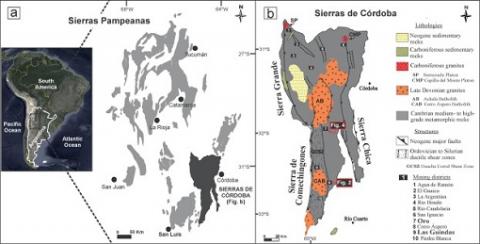M. Natalia Maffini, Klaus Wemmer, Stefania Radice, Sebastián Oriolo, Fernando D'Eramo, Jorge Coniglio, Manuel Demartis, Lucio Pinotti
2 017
Ore Geology Reviews Volume 89, October 2017, Pages 668-682
This paper discusses new structural, kinematic and geochronological data from polymetallic (Pb-Zn-Cu-Ag ± Au) vein-type deposits hosted in the metamorphic basement of the southern Sierras de Córdoba. A Carboniferous age was established for the hydrothermal event between ∼329 and 315 Ma (Late Mississippian-Early Pennsylvanian) by the K/Ar fine-fraction dating method of sericitic alteration related to metallic ore deposition in the Las Guindas and Oro districts. The obtained ages postdate the spatially associated Devonian magmatism and overlap the A-type Early Carboniferous magmatism defined for the Eastern Sierras Pampeanas. The presence of non-exhumed granitic bodies at shallow depths, possibly related to mineralization, is supported by available geophysical and field evidence.
The strain fabric and 3-D kinematic analyses constitute first kinematic data for the Carboniferous basement of the Southern Sierras Pampeanas demonstrating that mineralization was controlled by NNW- and ENE-trending brittle-ductile transtensional shear zones that overprint the earlier high-strain deformation fabrics of the basement. Transtensional deformation has accommodated large amounts of strike-slip movements and subordinated extensional components. The calculated kinematic axes indicate a coherent kinematic pattern of the mineralized systems in the two studied districts, with a maximum extension direction oriented NNE- to NE and maximum shortening direction oriented WNW- to NW. This deformation regime, active during mineralization, point to a non-compressive setting at the Late Mississippian-Early Pennsylvanian boundary. In line with other regional evidence, we propose a distinctive Carboniferous deformational phase in the Eastern Sierras Pampeanas, dominated by transtension. This period would have occurred after the transition with the Devonian compressional/transpressional orogenic regime.
The strain fabric and 3-D kinematic analyses constitute first kinematic data for the Carboniferous basement of the Southern Sierras Pampeanas demonstrating that mineralization was controlled by NNW- and ENE-trending brittle-ductile transtensional shear zones that overprint the earlier high-strain deformation fabrics of the basement. Transtensional deformation has accommodated large amounts of strike-slip movements and subordinated extensional components. The calculated kinematic axes indicate a coherent kinematic pattern of the mineralized systems in the two studied districts, with a maximum extension direction oriented NNE- to NE and maximum shortening direction oriented WNW- to NW. This deformation regime, active during mineralization, point to a non-compressive setting at the Late Mississippian-Early Pennsylvanian boundary. In line with other regional evidence, we propose a distinctive Carboniferous deformational phase in the Eastern Sierras Pampeanas, dominated by transtension. This period would have occurred after the transition with the Devonian compressional/transpressional orogenic regime.
https://www.sciencedirect.com/science/article/pii/S0169136817302366?via%3Dihub#!

